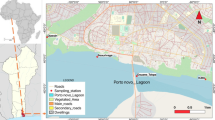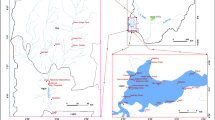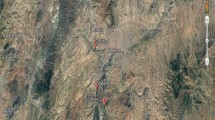Abstract
Background
As from last decade, the pollution of water bodies by chemical toxicants has become a topic of public discourse and concern in many countries. Polycyclic aromatic hydrocarbons (PAHs) are carcinogens and being ubiquitous in nature, are daily being released into water bodies as a result of anthropogenic sources.
Methods
The water samples were collected with plastic bottles/containers by dipping the sampler below the water surface to minimize the contamination of water sample by surface films and cocked below water surface to avoid air entrapment while the fish samples namely Clarias spp (Catfish) and Oreochromis spp (Tilapias) were purchased from fishermen at the bank of the river confluence. Three water samples each were collected from five sample points [A], [B], [C], [D] and [E] created for that purpose at each visit monthly for a period of six months and taken in an ice-cooler box to the laboratory. In all a total of 90 water samples and 20 fish samples were analysed. The water samples were preserved in a refrigerator below 4 °C prior to analysis. The concentrations of the sixteen US EPA priority polycyclic aromatic hydrocarbons (PAHs) were investigated using Gas chromatography coupled with Mass Spectrometer detector (GC-MS) after liquid-liquid and solid-liquid extractions.
Results
The concentrations of the six detected PAHs in water were of the following ranges: Nap(Not Detected {ND} to 0.543), Ph(ND to 0.083) Ant (ND to 0.083), BbF(0.080 to 0.093), BkF(0,083 to 0.093) and BaP(0.083 to 0.113) mg/L with distribution pattern of Nap>BaP > BbF=BkF > Ant = Ph. The mean concentration value of PAHs in Catfish and Tilapia were Nap(2.383 and 1.947), Ph(0.050 and 0.057), Ant(0.057 and 0.057), BbF(0.043 and ND), BkF(0.043 and ND) and BaP(0.050 and ND). The health risk assessment showed that the concentration of Benzo[a]pyrene, a known indicator of the presence of carcinogenic PAHs is of health risk concern. The PAHs were not significantly different in the water and fish respectively and the correlation studies showed that the PAHs were from the same source.
Conclusions
The study showed clearly that the levels of PAHs in the samples are of concern due to increasing pollution.

Similar content being viewed by others
References
Svensson BG, Nilsson A, Josson E, Schtüz A, Åkesson B, Hagmar L. Fish consumption and exposure to persistent organochlorine compounds, mercury, selenium and methylamines among Swedish fisherman. Scand J Work Environ Health. 1995;21:96–105.
UNFPA (United Nations Population Fund). Global Population and water access and Sustainability, Population and Development Strategies Series. New York, NY 10017. 2003.
Avishai N, Rabin OWHZ C, Moiseeva E, And Rinkeveh B. Genotoxicity of the Kishon River, Israel: The Application of an in vitro cellular assey. Mutation Res. 2002;518:21–37.
Mzoughi N, Chouba L. Heavy metals and PAH assessment based on mussel caging in the north coast of Tunisia (Mediterranean Sea). Int J Environ Res. 2012;6(1):109–18.
Cheng-Di D, Chih-Feng C, Chiu-Wen C. determination of polycyclic aromatic Hydrocarbons in industrial harbor sediments by GC-MS. Int J Environ Res Public Health. 2012;9(6):2175–88.
Opuene K, Okafor EC. Preliminary assessment of trace metals and polycyclic aromatic hydrocarbons in sediments. Int J Environ Sci Technol. 2007;4(2):233–40.
Bhupander K, Mukherjee DP, Sanjey K, Mishra M, Prakash D, Kingh SK, et al. Bioaccumulation of heavy metals in muscle tissue of fishes from selected aquaculture ponds in East Kolkata wetlands. Ann Biol Res. 2011;2(5):125–34.
Zafer A, Guler E, Sedat V, Murat O. Heavy metal accumulation in water sediments and fishes of Nallihan bird paradise, Turkey. J Environ Biol. 2007;28(2):545–9.
Ajiboye OO, Yakubu AF. Adams TE. A review of polycyclic aromatic Hydrocarbons and heavy metal contamination of fish from fish farms. J. Appl. Sci. Environ Manag. 2011;15(1):235–8.
Babatunde AM, Waidi OA, Adeolu AA. Bioaccumulation of heavy metals in fish(hydrocynusforskahlii, hyperopisusbebeOccidentalisand clariasgariepinus) organs indownstream Ogun coastal water, Nigeria. Transnational J Sci Technol. 2012;2(5):119–33.
Olubunmi EF, Edward OO. Polycyclic Aromatic Hydrocarbons (PAHs) and Polychlorinated Biphenyls (PCBs) in soils of Agbabu , Nigeria. Proceedings of 1st Annual International Interdisciplinary Conference, Azones Portugal. 2013:849–56.
Pruski AM, Dixon DR. Effects of cadmium on nuclear integrity and DNA repair efficiency in the gill cells of Mytilus Edulis. Aquat Toxicol. 2002;57:127–37.
Lee RF, Steinert S. Use of the single cell gel electrophoresis/comet Assey for detecting DNA damage in aquatic (marine and freshwater) animals. Mutation Res. 2003;544:43–64.
Obiakor MO, Okonkwo JC, Ezeonyejiaku CD, Okonkwo CN. Polycyclic aromatic Hydrocarbons (PAHs) in freshwater media: factorial effects and human dietary exposure risk assessment. Resource Environ. 2014;4(6):247–59.
Audu EB. An analytical view of temperature in Lokoja, Kogi state. Nigeria Int J Sci Technol. 2012;2(12):856–9.
Afolabi TA, Ogbnuneke CC, Ogunkunle OA, Bamiro FO. Comparative assessment of the potable quality of water from industrial, urban and rural parts of Lagos. Nigeria Ife J Sci. 2012;14(2):221–32.
United State Environmental Protection Agency. (US EPA) methodic description of procedure for isolating organic compounds from aqueous samples and concentration techniques suitable for preparing extract for appropriate determinative methods. Revision. 1996;3:1–8.
Shrivastava A, Gupta VB. Methods for the determination of limit of detection and limit of quantitation of the analytical methods. ChronYoung Sci. 2011;2(1):21–5.
USEPA Field sampling guidance Document N1215: Sediment sampling. U.S. EPA region 9 laboratory Richmond, Califorrnia, N1215, Rev. I. 1997.:1–10.
Ofosu FG, Afrifa CG, Bamford SA, Atiemo SM, IJK A, Gyampo O, et al. Health risk assessment of heavy metal exposure from soil dust at selected fuel filling stations in Accra. Int J Sci Technol. 2015;l4(7):289–96.
Ekere NR, Ihedioha JN, Eze IS, Agbazue VE. Health risk assessment in relation to heavy metals in water sources in rural regions of south East Nigeria. Int J Phys Sci. 2014;9(6):109–16.
World Health Organization. Polynuclear aromatic hydrocarbons in drinking-water. Background document for development of WHO guidelines for drinking-water quality. Geneva: World Health Organization; 2003.
European Commission. EC regulation 2015/1933 amending EC regulation 1881/2006 regarding maximum levels of PAHs in foodstuffs, Torino Italy. 2015.
Berto D, Cacciatore F, Ausili A, Sunseri G, Luca G, Bellucci LG, et al. Polycyclic aromatic Hydrocarbons (PAHs) from diffuse sources in coastal sediments of a not industrialised Mediterranean Island. Wat Air Soil Pollut. 2009;200:199–209.
Gobas FAPC, Wilcockson JB, Russell RW. Haffner GD mechanism of biomagnification in fish under laboratory and field conditions. Envir Sci Technol. 1999;33:133–41.
Fowler SW, Knauer GA. Role of large particles in the transport of elements and organic compounds through the oceanic water column. Prog Oceanog. 1986;16:147–94.
Raoux C, Bayona JM, Miquel JC, Teyssie JL, Fowler SW, Labaiés J. Particulate fluxes of aliphatic and aromatic hydrocarbons in near shore waters to the north - western Mediterranean Sea, and the effect of continental runoff. Estuar Coast Shelf Sci. 1999;48:605–16.
Jaward FM, Alegria HA, Galindo Reyes JG, Hoare A. Levels of PAHs in the waters, sediments, and shrimps of Estero de Urias, an estuary in Mexico, and their toxicological effects. In: Sci World J, vol. 2012; 2012. p. 1–9. https://doi.org/10.1100/2012/687034, Accessed on 23rd Jan 2018.
Nwaichia EO, Ntorgbo SA. Assessment of PAHs levels in some fish and seafood from different coastal waters in the Niger Delta. Toxicol Rep. 2016;3:167–72.
Nyarko E, Botwe BO, Klubi E. Polycyclic aromatic Hydrocarbons (P AHs) levels in T wo commercially important fish species from the coastal waters of Ghana and their carcinogenic health risks. West African J Appl Ecol. 2011;19:53–65.
Afshin Q, Farid M. Statistical analysis of accumulation and source of heavy metals occurrence in agricultural soils of Khoshk River banks, shiraz, Iran. American-Eurasian J Agric Environ Sci. 2007;2(5):565–73.
Gorleku MA, Carboo D, Palm LMN, Quasie WJ, Armah AK. Polycyclic aromatic hydrocarbons (PAHs) pollution in marine waters and sediments at the Tema Harbor, Ghana. Acad J Environ Sci. 2014;2(7):108–15.
Acknowledgements
The authors wish to acknowledge the assistance given by our Laboratory staff. Though they wish to remain at the background, we appreciate their assistance.
Author information
Authors and Affiliations
Corresponding author
Ethics declarations
Conflict of interest
There is no conflict of interest as regards this work.
Additional information
Publisher’s note
Springer Nature remains neutral with regard to jurisdictional claims in published maps and institutional affiliations.
Rights and permissions
About this article
Cite this article
Ekere, N.R., Yakubu, N.M., Oparanozie, T. et al. Levels and risk assessment of polycyclic aromatic hydrocarbons in water and fish of Rivers Niger and Benue confluence Lokoja, Nigeria. J Environ Health Sci Engineer 17, 383–392 (2019). https://doi.org/10.1007/s40201-019-00356-z
Received:
Accepted:
Published:
Issue Date:
DOI: https://doi.org/10.1007/s40201-019-00356-z




